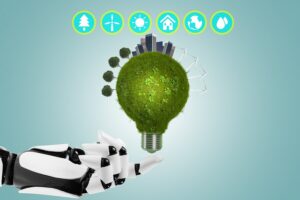Intelligent Grids, Smarter Future: How AI is Revolutionizing Energy Infrastructure?

In the quest for sustainable energy solutions, the intersection of artificial intelligence (AI) and energy grids emerges as a profound yet largely uncharted territory. As technology propels us into the future, integrating AI into energy grids is critical to unlocking unprecedented efficiency, reliability, and sustainability. This article embarks on a comprehensive exploration, delving into the intricacies of this dynamic relationship and unveiling the nuanced details of its potential impact.
Smart Grids: Beyond the Basics:
Smart grids represent a paradigm shift in energy infrastructure, but their true potential lies in the synergy with AI. Advanced sensors, communication networks, and real-time data analytics form the backbone of intelligent grids. When infused with AI algorithms, these grids transcend mere automation. They become adaptive systems capable of learning, optimizing, and evolving in response to dynamic energy demands and operational challenges.
Predictive Maintenance Redefined:
AI’s role in predictive maintenance goes beyond routine scheduling. By assimilating data from myriad sources – from sensor readings to historical performance metrics – AI algorithms can predict equipment failures with unparalleled accuracy. This predictive prowess minimizes downtime and optimizes maintenance schedules, leading to substantial cost savings and increased overall system reliability.
Energy Consumption Optimization on Multiple Fronts:
The application of AI in optimizing energy consumption extends to both macro and micro levels. Machine learning algorithms analyze intricate consumption patterns, weather forecasts, and real-time data to predict energy demands accurately. This foresight empowers energy providers to allocate resources efficiently, preventing peak-hour overload and ensuring a more stable and sustainable energy supply.
Integrating Renewables Seamlessly:
Renewable energy sources, while crucial for sustainability, pose challenges due to their intermittency. AI serves as the linchpin in mitigating these challenges. By forecasting renewable energy generation based on sophisticated analyses of weather patterns, AI enables energy grids to adjust operations dynamically. This adaptive approach ensures the seamless integration of renewable sources into the energy mix, maximizing their contribution to the grid.
How AI is Revolutionizing the Energy Grid:
The energy grid is a complex system that requires constant monitoring and management to ensure it operates efficiently and effectively. The energy grid is becoming more complex with the rise of renewable energy sources and the increasing demand for electricity. Fortunately, artificial intelligence (AI) is helping to revolutionize the energy grid by providing real-time insights and predictive analytics to help grid operators make better decisions.
AI aids the grid in three ways: by helping operators understand current conditions, make better decisions, and predict potential problems. The power grid system is often described as the most complex machine ever built. Because the grid is so vast, it is impossible for anyone to fully grasp everything happening within it at a given moment, let alone predict what will happen later. AI’s ability to learn from large amounts of data and respond to complex scenarios makes it particularly well-suited to stabilizing the grid.
Another way that AI is transforming the energy grid is by optimizing the use of renewable energy sources. As more renewable energy sources come online, the grid becomes increasingly complex. Millions of solar panels generate variable electricity, and unpredictable weather adds to the challenge of balancing demand with supply. To manage this complexity, grid operators are increasingly turning to AI. AI can help predict how much electricity will be needed the next day and develop the most cost-effective way to dispatch that energy. This can be done 12 times faster than is possible without AI, reducing the time required from nearly 10 minutes to 60 seconds 1.
AI is also helping to improve the efficiency of the energy grid. By analyzing real-time data, AI can identify areas where energy is wasted and suggest ways to optimize energy usage. For example, AI can predict when a piece of equipment will likely fail and schedule maintenance before it becomes a problem. This can reduce downtime and improve the overall efficiency of the grid.
Global Initiatives and Case Studies:
A panoramic view of international initiatives and successful case studies showcases the real-world impact of AI in energy grids. By examining diverse approaches from different regions, we gain insights into the global potential of this synergy. This section is a source of inspiration and a catalyst for cross-border collaboration and innovation.
Challenges and Ethical Considerations:
In the pursuit of progress, it is imperative to acknowledge the challenges and ethical considerations accompanying the integration of AI into energy grids. From ensuring data privacy to addressing algorithmic biases, this section confronts the complexities and prompts a thoughtful dialogue on the responsible deployment of AI technologies in the energy sector.
The unexplored synergy between artificial intelligence and energy grids promises a transformative journey toward a brighter, more resilient, sustainable energy landscape. As we navigate this intricate terrain, the collaborative efforts of researchers, policymakers, and industry leaders will shape a future where AI empowers us to harness the full potential of energy grids to benefit humanity and the planet.